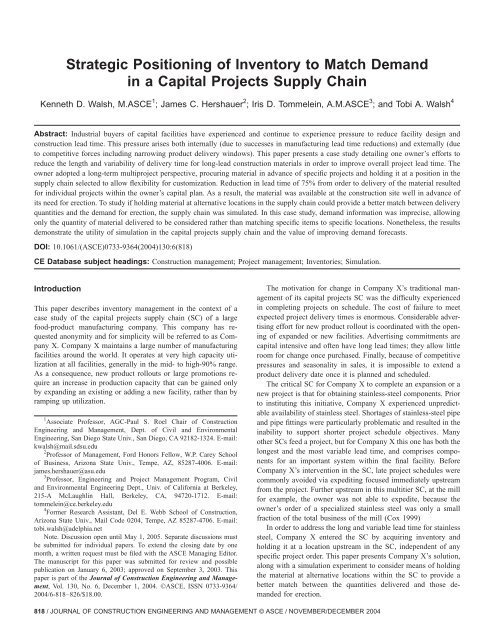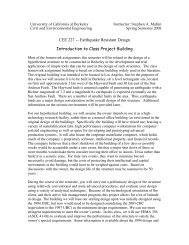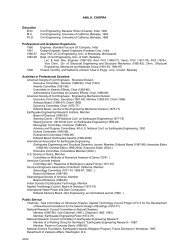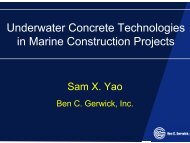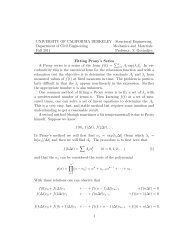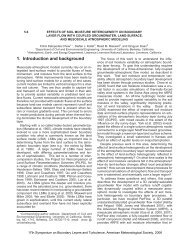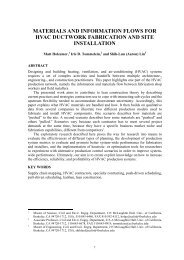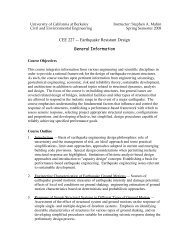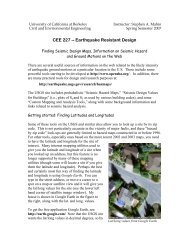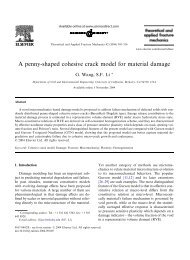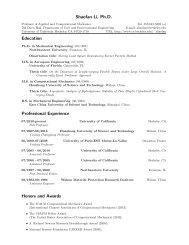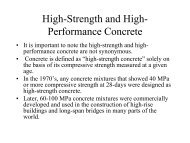Strategic Positioning of Inventory to Match Demand ... - ResearchGate
Strategic Positioning of Inventory to Match Demand ... - ResearchGate
Strategic Positioning of Inventory to Match Demand ... - ResearchGate
You also want an ePaper? Increase the reach of your titles
YUMPU automatically turns print PDFs into web optimized ePapers that Google loves.
Table 1. Classification <strong>of</strong> Simulation Case StudiesSimulationType Reference Industry GroupFig. 2. Schematic earned value development for pipe installation permonth at Company X projectsign where reference plant designs exist, as is the case here,the owner knows ahead <strong>of</strong> time what components will beneeded at what point in the construction sequence.In the present case, the owner seized control <strong>of</strong> the SC up <strong>to</strong>the point where materials arrived at the site. By considering thecontinuing and long-term expansion plans, Company X’s procurementexecutives could determine an appropriate level <strong>of</strong> upstreaminven<strong>to</strong>ry that would allow all possible expansion projects <strong>to</strong> proceedon schedule. It was not necessary <strong>to</strong> actually share any expansionplans. In fact, the manager <strong>of</strong> the facility holding theupstream inven<strong>to</strong>ry stated: “I have no idea why they want thismuch inven<strong>to</strong>ry.” Once materials were at the construction site, theowner left them under the control <strong>of</strong> the project. Project managersworking for the owner had incentives <strong>to</strong> make the project a successas compared <strong>to</strong> making their company a success overall.The owner’s procurement organization adopted a long-termview across projects, but realized that political fac<strong>to</strong>rs internal <strong>to</strong>the company would make it difficult <strong>to</strong> influence the management<strong>of</strong> projects at the site. Thus, rather than seeking <strong>to</strong> modify the SCdramatically, for example, by adopting a just-in-time (JIT) deliveryscheme, the owner’s procurement organization attemptedmerely <strong>to</strong> achieve earlier delivery <strong>of</strong> all stainless steel. Theirpower <strong>to</strong> influence management extended only <strong>to</strong> the projectfence. This supported the desire <strong>of</strong> the owner’s project managers<strong>to</strong> have large quantities <strong>of</strong> material on site early, but also createdthe need <strong>to</strong> manage substantial inven<strong>to</strong>ries on site.From data obtained from two projects, the researchers developedgeneric curves representing the rate at which constructionearned value for installed materials (Fig. 2). These curves showthat installation <strong>of</strong> piping takes place over a period <strong>of</strong> severalmonths, although typically delivery <strong>of</strong> nearly all piping was completedearly in the process.Origin and Evolution <strong>of</strong> Supply Chain SimulationThe origin <strong>of</strong> SC modeling is credited <strong>to</strong> Forrester (1958, 1961).Forrester describes a four-tiered SC architecture consisting <strong>of</strong> afac<strong>to</strong>ry, warehouse, distribu<strong>to</strong>r, and retailer, on which he basedsimulation studies <strong>to</strong> explain, for example, the “bullwhip” effect.He eschewed the isolationist focus characterizing operations researchin the 1950’s in favor <strong>of</strong> an intracompany approach, believingthat management should focus on the interactions tha<strong>to</strong>ccur at each <strong>of</strong> the interfaces within the SC.Angerh<strong>of</strong>er and Angelides (2000) follow the evolution <strong>of</strong> SCsimulation since Forrester’s work. They provide an excellent synopsis<strong>of</strong> research and development performed through the 1980’sand 1990’s. Recent work in SC simulation focuses on the development<strong>of</strong> frameworks and their application <strong>to</strong> case studies. Most<strong>Inven<strong>to</strong>ry</strong>managementProcessimprovementForecasting/demandmanagementArchibald et al. (1999)Barnett and Miller (2000)King and Moon (1999)Parsons and Siprelle (2000)Schunk and Plott (2000)Swaminathan et al. (1998)Trone et al. (2000)AbouRizk et al. (1999)Halpin and Martinez (1999)Ingalls and Kasales (1999)Ioannou (1999)Law and McComas (1999)Price and Harrell (1999)Sawhney et al. (1999)Tommelein (1997)Tommelein (1998)Bhaskaran (1998)Mallya et al. (2001)Raghunathan (1999)Food ManufacturingRetail ManufacturingFabric ManufacturingFood ManufacturingAu<strong>to</strong> ManufacturingFood ManufacturingConstructionConstructionConstructionComputer ManufacturingConstructionVarious ManufacturingRetail ManufacturingConstructionConstructionConstructionAu<strong>to</strong> ManufacturingRetail ManufacturingRetail Manufacturingcase studies rely on highly cus<strong>to</strong>mized proprietary simulation environments(Bhaskaran 1998; Archibald et al. 1999; Trone et al.2000). Such modeling efforts tend <strong>to</strong> originate from substantialplayers in the marketplace, due <strong>to</strong> the prohibitive cost <strong>of</strong> developingthese frameworks. However, significant efforts are underwayin developing general-purpose object-oriented simulation environments,typically featuring a drag-and-drop graphical userinterface design and adequate flexibility for application in manyindustries. Such environments commonly use the event schedulingparadigm or block languages. By contrast, construction simulationhas commonly been accomplished with general-purposesimulation environments based on the activity scanning paradigm,which seems <strong>to</strong> provide a more natural fit. The environments mostcommonly used <strong>to</strong> simulate construction are SIMPHONY (Hajjarand Abourizk 1999) and STROBOSCOPE (Martinez 1996).As part <strong>of</strong> the literature review for this study, 19 articles weresampled from the proceedings <strong>of</strong> a recent simulation conference.Seven <strong>of</strong> these involve construction, the remainder involve manufacturing.Table 1 categorizes each case study, based on its primaryfocus <strong>of</strong> analysis, in<strong>to</strong> one or more <strong>of</strong> the following problemtypes:• <strong>Inven<strong>to</strong>ry</strong> management,• Process improvement, and• Forecasting/demand management.Note that some references include more than one case study,and some case studies analyzed more than one problem type. Thecases presented in Table 1 are indicative <strong>of</strong> the <strong>to</strong>ne, if not thecontents, <strong>of</strong> the relevant literature.<strong>Inven<strong>to</strong>ry</strong> management case studies are common in manufacturing,and focus on optimizing service level and process time byvarying either the location or quantity <strong>of</strong> inven<strong>to</strong>ry among severalalternatives. Such studies usually involve multiple tiers in the SC.<strong>Inven<strong>to</strong>ry</strong> management is less frequently studied in construction.This may be because construction simulation has traditionally focusedon on-site operations, where greater inven<strong>to</strong>ry (more mate-820 / JOURNAL OF CONSTRUCTION ENGINEERING AND MANAGEMENT © ASCE / NOVEMBER/DECEMBER 2004
Fig. 3. Value stream map for stainless-steel pipe and fittingsrials on site) is generally—though erroneously in our opinion—perceived <strong>to</strong> be better. The physical constraints encountered onconstruction sites relative <strong>to</strong> the dimensions <strong>of</strong> materials handledalso make a layout problem formulation more natural than a locationproblem formulation (Francis et al. 1992).Process improvement case studies are prevalent in the constructionindustry, and <strong>of</strong>ten have a site focus, with little or noemphasis on management <strong>of</strong> the SC interfaces that Forrester espoused.For example, alternatives may include additions/deletions<strong>of</strong> capacity by increasing/decreasing crew or machine size at variouslocations within the system. They may also include alternativemethods that achieve the same objective.Forecasting and demand management simulation is done <strong>to</strong>either anticipate or mitigate risk due <strong>to</strong> consumer behavior. Theauthors are not aware <strong>of</strong> construction case studies that consideredthis problem type. By contrast, this problem is addressed as eithera primary or secondary focus <strong>of</strong> simulation in a significant number<strong>of</strong> manufacturing case studies. This type <strong>of</strong> simulation is done<strong>to</strong> analyze the transmission <strong>of</strong> instability up the SC (bullwhipeffect), determine the impact <strong>of</strong> new channels on the marketplace,stabilize forecasts <strong>to</strong> suppliers, etc. It may lead <strong>to</strong> improvementsin scheduling, inven<strong>to</strong>ry management, or workflow.Applicability <strong>of</strong> Supply Chain Simulation in theConstruction IndustrySCM is more mature in manufacturing than in construction, asindicated by many differences in the modeling and analysis approachesbetween these industry sec<strong>to</strong>rs, including the widespreaduse <strong>of</strong> simulation <strong>to</strong>ols <strong>to</strong> optimize SC relationships inmanufacturing. Few cases in the construction literature involvesimulation <strong>of</strong> multiple tiers in the SC. Consideration is typicallygiven <strong>to</strong> the transfer and inven<strong>to</strong>ry <strong>of</strong> goods within one tier, ratherthan <strong>to</strong> optimizing the hand<strong>of</strong>f or inven<strong>to</strong>ry levels between tiers.Some exceptions are notable, however. Tommelein (1998) addressesthe difficulty in applying SC concepts due <strong>to</strong> the unique“matching” problem faced in construction: A significant fraction<strong>of</strong> the materials delivered <strong>to</strong> the construction site must be preciselymatched <strong>to</strong> their installation location. Contrac<strong>to</strong>rs are heldliable for completion dates, but they usually become involved inthe delivery process <strong>to</strong>o late <strong>to</strong> be able <strong>to</strong> control the SC upstream<strong>of</strong> the site other than via expediting. Accordingly, contrac<strong>to</strong>rs seekthe earliest possible delivery <strong>of</strong> materials at the site rather thanseek delivery designed <strong>to</strong> correspond <strong>to</strong> planned installation. InJOURNAL OF CONSTRUCTION ENGINEERING AND MANAGEMENT © ASCE / NOVEMBER/DECEMBER 2004 / 821
Fig. 4. CYCLONE simulation model <strong>of</strong> the stainless-steel pipe and fittings supply chainother words, they want <strong>to</strong> get the material in<strong>to</strong> a position in theSC within their reach, literally and figuratively, and for the mostpart their reach extends only <strong>to</strong> the site. <strong>Inven<strong>to</strong>ry</strong> <strong>of</strong> material maybuild up on the site as a consequence <strong>of</strong> this approach, but becauseowners have been <strong>to</strong>ld it leads <strong>to</strong> more reliable projectdelivery, they appear willing <strong>to</strong> pay the associated costs. Largeinven<strong>to</strong>ries are one (costly) means <strong>to</strong> decouple site work from theupstream SC (Howell et al. 1993).Tommelein et al. (1999) showed that variability in productionlevels for closely coupled subcontrac<strong>to</strong>rs results in decreasedoverall throughput. Bashford et al. (2003) described the implications<strong>of</strong> different production management strategies in the residentialSC, in particular for subcontracted workload variability.Arbulu et al. (2002) demonstrated the impact <strong>of</strong> batch sizing andmultitasking on process throughput in a pipe support design andfabrication context. Each <strong>of</strong> these examples included key resultsmeasures related <strong>to</strong> production levels over time for different alternatives.Many manufacturing cases consider production levels overtime, but also emphasize financial performance. They evaluatecosts <strong>of</strong> inven<strong>to</strong>ry and production management, <strong>of</strong>ten both beforeand after tax (Table 2). Construction simulations may well includecost considerations, but usually with less sophistication.Furthermore, they frequently ignore inven<strong>to</strong>ry management costsor treat them only conceptually, even if inven<strong>to</strong>ry levels are presented.This may be because the complexity <strong>of</strong> the capital projectsSC <strong>of</strong>ten hides inven<strong>to</strong>ry holding expenses, or because incentiveand penalty structures <strong>of</strong>ten focus on time. Given that costs associatedwith inven<strong>to</strong>ry management on site are not tracked veryprecisely, it should not be surprising that quantification <strong>of</strong> holdingcosts upstream in the SC is rare as well. In any event, we do notpresent explicit inven<strong>to</strong>ry holding cost calculations either. Moreresearch is needed <strong>to</strong> substantiate such costs; we speculate thatlower inven<strong>to</strong>ry levels at the construction site or points upstreamin the SC would result in lower inven<strong>to</strong>ry management costs andimproved SC performance overall.That construction simulation tends <strong>to</strong> focus on process improvementis an indication <strong>of</strong> the infancy <strong>of</strong> the application <strong>of</strong> SCconcepts <strong>to</strong> the industry. The enormous challenges in constructioninven<strong>to</strong>ry management have only recently been recognized, andleave vast opportunities for research and development in<strong>to</strong> theapplication <strong>of</strong> SC simulation. For example, in an extensive study<strong>of</strong> piping projects, Howell and Ballard (1996) observed thatproject success appeared <strong>to</strong> correlate <strong>to</strong> having 60% <strong>of</strong> the pipespools on hand by the time 20% <strong>of</strong> the pipe has been installed.This correlation is in keeping with Company X’s mindset andactions <strong>to</strong> achieve early delivery. Current practice notwithstanding,Howell and Ballard promoted more reliable planning andTable 2. Typical Simulation Performance Measures by Problem Type<strong>Inven<strong>to</strong>ry</strong> management Process improvementForecasting/demandmanagementGross margin Service level Absolute forecast errorGross margin return on Total inven<strong>to</strong>ry Service levelinvestment Time in process Total inven<strong>to</strong>ryService level Queue size (wait time)Total inven<strong>to</strong>ryUtilizationTime in process Costs (<strong>to</strong>tal, product,Utilizationentity, inven<strong>to</strong>ry,Costs (<strong>to</strong>tal, product, processing, andentity, inven<strong>to</strong>ry,transportation)processing, and Net pr<strong>of</strong>it after taxtransportation)Sales<strong>Inven<strong>to</strong>ry</strong> turnsPr<strong>of</strong>it marginReturn on assetsS<strong>to</strong>ckout delay822 / JOURNAL OF CONSTRUCTION ENGINEERING AND MANAGEMENT © ASCE / NOVEMBER/DECEMBER 2004
judicious inven<strong>to</strong>ry reduction as means <strong>to</strong> achieving better performance.Mapping the Supply ChainSimulation <strong>of</strong> any SC begins by identifying the processing tasks,delays, transportation requirements, and holding positions <strong>of</strong> resourcesin buffers through interview and observation <strong>of</strong> managers,subject-matter experts, and stakeholders within the SC, as wasdone for Company X. The SC map for stainless-steel pipe andpipe fittings depicted in Fig. 3 uses symbols based on Damelio(1996).In 1995, Company X recognized the pernicious effects <strong>of</strong> thelength and variability <strong>of</strong> its stainless-steel SC, and decided <strong>to</strong>intervene in order <strong>to</strong> reduce the lead time. Company X consideredthe locations shown as triangles in Fig. 3 as holding places, andultimately chose the one labeled “Owner <strong>Inven<strong>to</strong>ry</strong>.” This selectionwas made based on intuition and convenience rather thanbased on any detailed analysis. Locations further upstream wereconsidered <strong>to</strong>o far away <strong>to</strong> control. However, by the time pipereached tiers further downstream, it had been cus<strong>to</strong>mized sufficiently<strong>to</strong> reduce flexibility. Company X contracted with a singleindependent distribu<strong>to</strong>r <strong>to</strong> s<strong>to</strong>re, handle, and control material. Theowner placed an amount <strong>of</strong> pipe roughly equivalent <strong>to</strong> the amountused for one new manufacturing facility in<strong>to</strong> the inven<strong>to</strong>ry.The distribu<strong>to</strong>r provided tracking information on pipe, fittings,and flanges <strong>to</strong> Company X. This information had not previouslybeen available from any member <strong>of</strong> the SC, and has allowedimproved planning and scheduling and the data <strong>to</strong> evaluate theowner’s capital program. Costs incurred by Company X for carryingthis inven<strong>to</strong>ry have been more than <strong>of</strong>fset by price savingsachieved through bulk purchases and through commodity savingsowing <strong>to</strong> inflation and market volatility in stainless-steel prices.The map depicted in Figure 3 was developed via interviewswith Company X personnel within the purchasing and capitalfacilities development departments. In addition, upstream SCmember input was sought via interviews with personnel from thedistribu<strong>to</strong>r and the pipe manufacturer. Faculty researchers conductedthe interviews and an intern on a ten-week assignmentwithin Company X assisted in obtaining more detailed information,including the data needed <strong>to</strong> estimate the delay times shownin Fig. 3 [see Walsh et al. (2002) for additional anecdotal details].Simulation <strong>of</strong> the Supply ChainThe SC map (Fig. 3) was used <strong>to</strong> develop a simulation model(Fig. 4) in order <strong>to</strong> consider the implications <strong>of</strong> alternative holdingpoints for inven<strong>to</strong>ry on the arrival <strong>of</strong> stainless-steel pipe andTable 3. Summary <strong>of</strong> Simulation Experiments with Multiple <strong>Inven<strong>to</strong>ry</strong>Holding LocationsSimulation experiment codeStarting locationsCompany X’simplementation M1 M2 M3Mill 0% 20% 30% 40%Pipe manufacturer 0% 50% 50% 40%Distribu<strong>to</strong>r 100% 30% 20% 20%fittings at the construction site. The simulation experiments wereconducted using the CYCLONE template in SIMPHONY. Thepipe and fittings were broken in<strong>to</strong> 100 packets, each representing1% <strong>of</strong> the <strong>to</strong>tal <strong>to</strong> be used. The primary output <strong>of</strong> interest was thearrival <strong>of</strong> material at the site versus time.Since most <strong>of</strong> the time from order <strong>to</strong> delivery is schedulingwait time, process time and wait time were combined in<strong>to</strong> a singledelay time. This simplification should not indicate the lack <strong>of</strong>possible supplier scheduling or process improvements withinthese individual steps, but rather that it is currently difficult forCompany X <strong>to</strong> exert influence over those processes.All simulation runs are based on the model presented in Fig. 4,with the following alternatives varying the location <strong>of</strong> inven<strong>to</strong>ry:• All inven<strong>to</strong>ry held ahead <strong>of</strong> the Mill,• <strong>Inven<strong>to</strong>ry</strong> prepositioned at a Distribu<strong>to</strong>r, and• Multiple holding locations (Table 3).Calibration and validation <strong>of</strong> the model used individual processdurations established based on interviews and invoice datataken from the files <strong>of</strong> Company X and its Distribu<strong>to</strong>r, against theknown overall arrival times. The case in which the stainless steelwas ordered, processed from ingots queued before the steel mill,was considered first. Based on a review <strong>of</strong> order data in CompanyX’s files and interviews with SC participants, the processing timesfor each stage in the SC were allowed <strong>to</strong> vary within a uniformdistribution. The extent <strong>to</strong> which results might be affected by theselection <strong>of</strong> alternative distributions was not studied. This modelwas evaluated for a range <strong>of</strong> iterations from 10 <strong>to</strong> 1,000. Nosignificant change in the average and standard deviation <strong>of</strong> thecompletion <strong>of</strong> delivery <strong>to</strong> the site was noted after 100 iterations.The second case assumed that all <strong>of</strong> the stainless steel needed wasin s<strong>to</strong>rage at the Distribu<strong>to</strong>r when ordered for the project. Thisalternative models the 1995 SC intervention by Company X.The simulated arrival times at the site for these two cases areshown in Fig. 5. The figure shows the average result for 100iterations <strong>of</strong> the model (solid line) along with the three-standarddeviationrange (gray line). Shipping and receiving records wereavailable for a small number <strong>of</strong> projects conducted under bothapproaches, allowing the writers <strong>to</strong> develop fairly general informationabout the actual arrival times which result from each. Theresults <strong>of</strong> the simulation show reasonable agreement with theseFig. 5. Arrival time at site for cases with all material starting at the mill and distribu<strong>to</strong>rJOURNAL OF CONSTRUCTION ENGINEERING AND MANAGEMENT © ASCE / NOVEMBER/DECEMBER 2004 / 823
Fig. 6. Impact <strong>of</strong> distribu<strong>to</strong>r batch size on arrival time pr<strong>of</strong>ileactual arrival times. Furthermore, the results were discussed withpersonnel at Company X, who indicated that these resultsmatched their expectations. More comprehensive validation/calibration would be desirable in the general case, but the lack <strong>of</strong>extensive record keeping made such activities impractical. Alsoshown for reference is the schematic demand curve (Fig. 2,dashed line), adjusted <strong>to</strong> the week <strong>of</strong> first delivery.As expected, the use <strong>of</strong> prepositioned inven<strong>to</strong>ry located at theDistribu<strong>to</strong>r buffers the project from the long and variable SC upstream<strong>of</strong> the site. The average time <strong>to</strong> complete delivery (arrival<strong>of</strong> 100% <strong>of</strong> the pipe) is reduced by about 78%, from 38 weeks <strong>to</strong>8 weeks. Variability in complete delivery time is reduced as well,judging by the three standard deviation range.Batching policies in the upper portions <strong>of</strong> the SC have notbeen modeled directly. Rather, the process times for elementsupstream <strong>of</strong> the Distribu<strong>to</strong>r include batching effects and schedulingdelays. Even pre-1995, a distribu<strong>to</strong>r was present <strong>to</strong> act as aconsolida<strong>to</strong>r <strong>of</strong> nearly finished goods. In some cases, the distribu<strong>to</strong>rwould collect all <strong>of</strong> the pipe and fittings before releasing themdownstream. Or, the distribu<strong>to</strong>r might serve as a routing agent,handling material with only minimal s<strong>to</strong>rage time; intermediateconditions are also possible. Given the importance <strong>of</strong> batchingpolicies on SC performance (e.g., Arbulu et al. 2002), the impact<strong>of</strong> these decisions was further evaluated. Fig. 5 depicted the simulationresults using a batch size <strong>of</strong> 1%. Fig. 6 depicts the simulationresults with batch sizes <strong>of</strong> 25% and 100%. These resultsillustrate that in this system (though it may not generally be thecase) large batches affect the first arrival more than the completion<strong>of</strong> delivery. Variability also is higher when larger batches areused.This comparison brings out the import <strong>of</strong> the slope <strong>of</strong> the sitearrival curves (Figs. 5 and 6). This slope represents the arrivalrate <strong>of</strong> material at the site per week, or the arrival rate. The constructionmanagement philosophy for Company X relies uponearly delivery <strong>of</strong> pipe and fittings <strong>to</strong> the site (the left-most curvein Fig. 5). While there is some variation over time in demand forpipe during construction (Fig. 2), the demand pattern is relativelysteady over the construction process and extends over a longerduration than that <strong>of</strong> any scenario considered thus far. Fig. 5shows that the dashed line representing actual installation <strong>of</strong> pipeis well below the simulated delivery pattern throughout theproject, even <strong>to</strong> the three-standard-deviation range. As a consequence,the project will require on-site laydown space for nearlyall <strong>of</strong> the pipe delivered. The advantages <strong>of</strong> this early delivery <strong>to</strong>craft assignment flexibility may be <strong>of</strong>fset by a lack <strong>of</strong> flexibility <strong>to</strong>revise the actual pipe material in response <strong>to</strong> changes after arrival,costs associated with s<strong>to</strong>rage and rehandling, and damage/loss <strong>of</strong>pipe while s<strong>to</strong>red on site.Tommelein (1998) presented a number <strong>of</strong> potential advantages<strong>of</strong> coordination in a pull-driven system in which pipe was delivereda short time before it was required by the construction activity.In the present case, one mechanism for extending the deliverywindow <strong>to</strong> better match the construction demand is presented byprepositioning inven<strong>to</strong>ry at multiple locations upstream <strong>of</strong> thesite. Three scenarios <strong>of</strong> this type were considered, with the pipeinven<strong>to</strong>ry divided among three locations (Table 3). These locationswere selected based on trial and error <strong>to</strong> develop a moregradual arrival pattern.Fig. 7 shows the resulting site arrival time his<strong>to</strong>ries. To providea sense <strong>of</strong> the range in the simulation results without undulycluttering the graph, only the M1 minus-three-standard-deviationsand the M3 plus-three-standard-deviations curves are included.The average curves from Fig. 5 and the actual usage data fromFig. 2 are shown for reference. These models demonstrate that adelivery pattern, much more in keeping with the demand patterns,can be created by the choice <strong>of</strong> holding locations for prepositionedinven<strong>to</strong>ry. In doing so, risk is not significantly increased, aseven the three-standard-deviation range <strong>of</strong> the arrival curve is stillahead <strong>of</strong> demand, but laydown space and inven<strong>to</strong>ry managementrequirements are significantly reduced.Pipe deliveries were assumed <strong>to</strong> be interchangeable, but thisunderstates the communication and coordination efforts required<strong>to</strong> make the inven<strong>to</strong>ry prepositioning and the affiliated cus<strong>to</strong>mizationmatch the construction schedule. With no intention <strong>to</strong> minimizethe difficulty <strong>of</strong> these efforts, the objective here is merely <strong>to</strong>demonstrate a method by which the delivery pattern can be approximatelymatched <strong>to</strong> the construction demand pattern.DiscussionThe results presented in Fig. 7 demonstrate that locating and sizingbuffers in the SC serve as a means <strong>of</strong> matching demand andsupply levels at the construction site. JIT philosophies have beeneffectively used in manufacturing settings <strong>to</strong> match supply anddemand, thereby reducing the need for onsite inven<strong>to</strong>ries. Propagatedup the SC, a JIT management system can reduce inven<strong>to</strong>rylevels, and the related costs, systemically. Company X’s approachobviously increases inven<strong>to</strong>ry, at least at one tier. However, theobjective was <strong>to</strong> size and locate the required inven<strong>to</strong>ries for thesystem while considering project risk, and <strong>to</strong> place them in thehands <strong>of</strong> the party best able <strong>to</strong> manage them.Company X’s approach should be compared <strong>to</strong> the earlyproject procurement approach known as PEpC (Vorster et al.1998) as the difference is subtle but important. PEpC espousessupplier involvement in project design, and procurement <strong>of</strong> longleaditems at the start <strong>of</strong> engineering <strong>to</strong> reduce <strong>to</strong>tal project leadtime. In contrast, Company X ordered, and even <strong>to</strong>ok delivery viatheir distribu<strong>to</strong>r, <strong>of</strong> critical long-lead materials even in advance <strong>of</strong>a specific project on which <strong>to</strong> use those materials.Prepositioning the long-lead materials in the SC has the addedadvantage <strong>of</strong> delaying irreversible cus<strong>to</strong>mization as compared <strong>to</strong>holding the material on site. For simplicity, assume that the degree<strong>of</strong> irreversible cus<strong>to</strong>mization grows more or less steadily as824 / JOURNAL OF CONSTRUCTION ENGINEERING AND MANAGEMENT © ASCE / NOVEMBER/DECEMBER 2004
Fig. 7. Arrival time at site versus time for multiple holding locationmodels M1–M3 (Table 3)the material moves along the SC, while the delivery time decreasessteadily (Fig. 8). For this case, since the delivery timefrom the mill was unacceptably long, the owner moved materialdownstream in the SC (in the direction shown under the horizontalaxis). The owner thereby lost the ability <strong>to</strong> influence the processesconducted upstream <strong>of</strong> the distribu<strong>to</strong>r (such as the specification<strong>of</strong> the steel chemistry or pipe diameters), but accepted thisloss in favor <strong>of</strong> reduced delivery time. In the scenarios presentedin Fig. 7, with material deployed at multiple locations in the SC,the owner can cus<strong>to</strong>mize, and the resulting delivery pattern is notunduly different from the demand pattern.Another approach, not used in this case, is so-called postponement.In a postponement strategy, the SC is reconfigured so thatirreversible cus<strong>to</strong>mization is delayed by changes <strong>to</strong> the productand/or the process (the labeled arrow in Fig. 8). The advantage <strong>of</strong>postponement is that delivery times can be reduced more for agiven level <strong>of</strong> irreversible cus<strong>to</strong>mization. To date, Company Xhas not attempted <strong>to</strong> change their processes or products <strong>to</strong> supportpostponement. Evaluation <strong>of</strong> the degree <strong>of</strong> irreversible cus<strong>to</strong>mizationat different points in the SC is an interesting field for potentialnew research, in particular for the assessment <strong>of</strong> the cost/benefit relationships for the lost flexibility <strong>of</strong> early delivery.Summary and Conclusions<strong>Inven<strong>to</strong>ry</strong> management in construction requires striking the balancebetween the contrac<strong>to</strong>r’s desire <strong>to</strong> have materials on siteearly in a project, and the SC benefits from inven<strong>to</strong>ry reduction.At one extreme, 100% inven<strong>to</strong>ry prior <strong>to</strong> project commencementmaximizes crew assignment flexibility and eliminates the possibility<strong>of</strong> construction delays due <strong>to</strong> shipment delays. However,this is costly due <strong>to</strong> the up-front capital requirement, inven<strong>to</strong>ryholdingcosts, damage/loss <strong>of</strong> materials, inflexibility in response<strong>to</strong> design changes, and lack <strong>of</strong> planning that may result fromperceived flexibility. At the other extreme, reliance on a JIT philosophyplaces the contrac<strong>to</strong>r at the mercy <strong>of</strong> their suppliers andat risk <strong>of</strong> incurring construction delay. However, JIT is beneficialin terms <strong>of</strong> savings in up-front capital, minimization <strong>of</strong> inven<strong>to</strong>ryholdingcosts, reduction in damage/loss <strong>of</strong> materials, increasedflexibility in response <strong>to</strong> design changes, and improved performancethanks <strong>to</strong> the enforced planning reliability.Prepositioning inven<strong>to</strong>ry in order <strong>to</strong> match the supply with thecontrac<strong>to</strong>r’s demand is one solution <strong>to</strong> minimizing risk <strong>to</strong> bothowner and contrac<strong>to</strong>r. While in this case, the owner exerted controlover the SC by obtaining and holding inven<strong>to</strong>ry in the SC, inthe general case other members <strong>of</strong> the SC, including the contrac<strong>to</strong>rand key suppliers, could likewise adopt such a role. The reasonswhy the owner is well positioned for the kind <strong>of</strong> controlmechanism adopted in this case were described, and include theowner’s detailed knowledge <strong>of</strong> their upcoming demand for facilitiesand their interest in maintaining the secrecy <strong>of</strong> product promotionplans.A supplier might wish <strong>to</strong> gain control <strong>of</strong> the SC in order <strong>to</strong>increase market share and stabilize their demand through development<strong>of</strong> a larger risk pool. Further, a supplier may take overmore parts <strong>of</strong> the SC in order <strong>to</strong> acquire technologies or blockcompeti<strong>to</strong>rs’ access <strong>to</strong> those technologies. The primary motivationfor the contrac<strong>to</strong>r <strong>to</strong> seek control <strong>of</strong> a SC is <strong>to</strong> control lead timeand improve their ability <strong>to</strong> successfully navigate the matchingproblem. Because they are mainly service providers, however, itis harder for general contrac<strong>to</strong>rs <strong>to</strong> exert control over the SC thanit is for subcontrac<strong>to</strong>rs, who are more likely <strong>to</strong> also have a productstream.The owner in this case used inven<strong>to</strong>ries <strong>of</strong> physical goods <strong>to</strong>reduce lead times. <strong>Inven<strong>to</strong>ry</strong> was held at a location in the SC untilneeded for a project. Simulation demonstrated that variation inthe level and location <strong>of</strong> inven<strong>to</strong>ry is one strategy for modifyingthe material delivery rate. SC reconfiguration <strong>to</strong> support postponementis another strategy. Perhaps, another strategy would be<strong>to</strong> acquire virtual inven<strong>to</strong>ry, in the form <strong>of</strong> guaranteed manufacturingcapacity at the mill. However, this strategy can be problematic<strong>to</strong> deploy in a long SC, because the power <strong>of</strong> one buyergenerally diminishes as one moves up the SC. The writers hasten<strong>to</strong> point out that the success <strong>of</strong> this strategy seems tightly coupled<strong>to</strong> the ability <strong>of</strong> the owner <strong>to</strong> accurately forecast demand for newfacilities. However, additional research is needed <strong>to</strong> quantify thisrelationship.The results <strong>of</strong> these simulations were presented <strong>to</strong> CompanyX, leading <strong>to</strong> several policy changes. Recent conversations withCompany X reveal that their approach has, in fact, been modifiedin favor <strong>of</strong> the multiple holding place strategy. Specifically, whilethe same distribu<strong>to</strong>r location has been maintained, some ownerinven<strong>to</strong>ry is now kept in front <strong>of</strong> the pipe manufacturer, providingincreased flexibility <strong>to</strong> produce different pipe sizes. Discussionsare being held <strong>to</strong> reserve some mill capacity. These actions confirmthe practicability <strong>of</strong> multiple points <strong>of</strong> inven<strong>to</strong>ry as shown inthe simulation.AcknowledgmentsFig. 8. Relationship between irreversible cus<strong>to</strong>mization, deliverytime, and position in the supply chainThis project is based upon work, supported in part, by the ConstructionIndustry Institute. The opinions, conclusions, and recommendationsexpressed are those <strong>of</strong> the writers, and are notnecessarily shared by the Construction Industry Institute. Shouldthey, upon reading this, recognize themselves, employees <strong>of</strong>Company X should know the writers are deeply grateful <strong>to</strong> them.Ms. Lindsay Brown and Mr. Michael Wu were instrumental in theJOURNAL OF CONSTRUCTION ENGINEERING AND MANAGEMENT © ASCE / NOVEMBER/DECEMBER 2004 / 825
data collection required for the development <strong>of</strong> the maps presentedin this work.ReferencesAbouRizk, S. M., Ruwanpura, J. Y., Er, K. C., and Fernando, S. (1999).“Special purpose simulation template for utility tunnel construction.”Proc., 1999 Winter Simulation Conf., IEEE, Phoenix, 948–955.Angerh<strong>of</strong>er, B. J., and Angelides, M. C. (2000). “System dynamics modelingin supply chain management: Research review.” Proc., 2000Winter Simulation Conf., IEEE, Orlando, Fla., 342–351.Arbulu, R. J., Tommelein, I. D., Walsh, K. D., and Hershauer, J. C.(2002). “Contribu<strong>to</strong>rs <strong>to</strong> lead time in construction supply chains: Case<strong>of</strong> pipe supports used in power plants.” Proc., 2002 Winter SimulationConference, IEEE, San Diego, 1745–1751.Archibald, G., Karabakal, N., and Karlsson, P. (1999). “Supply chainversus supply chain: Using simulation <strong>to</strong> compete beyond the fourwalls.” Proc., 1999 Winter Simulation Conf., IEEE, Phoenix, 1207–1214.Barnett, M. W., and Miller, C. J. (2000). “Analysis <strong>of</strong> the virtual enterpriseusing distributed supply chain modeling and simulation: An application<strong>of</strong> e-SCOR.” Proc., 2000 Winter Simulation Conf., IEEE,Orlando, Fla., 352–361.Bashford, H. H., Sahwney, A., Walsh, K. D., and Kot, K. (2003). “Implications<strong>of</strong> even flow production methodology for U.S. housing industry.”J. Constr. Eng. Manage., 129(3), 330–337.Bhaskaran, S. (1998). “Simulation analysis <strong>of</strong> a manufacturing supplychain.” Decision Sci., 29(3), 633–657.Cox, A. (1999). “Power, value, and supply chain management.” SupplyChain Manage. J., 4(4), 167–175.Cox, A., and Ireland, P. (2002). “Managing construction supply chains:The common sense approach.” Eng., Constr., Archit. Manage., 9(5/6),409–418.Crutcher, C. A., Walsh, K. D., Hershauer, J. C., and Tommelein, I. D.(2001). “Effects <strong>of</strong> a preferred vendor relationship on an electricalcomponent supplier and an electrical contrac<strong>to</strong>r: A case study.” Proc.Ninth Annual Conf. Intl. Group for Lean Construction (IGLC-9),IGLC, Singapore.Damelio, R. (1996). The basics <strong>of</strong> process mapping, Productivity Press,N.Y.Forrester, J. W. (1958). “Industrial dynamics: A major breakthrough fordecision makers.” Harvard Bus. Rev., 36(4), 37–66.Forrester, J. W. (1961). Industrial dynamics, Productivity Press, Portland,Ore.Francis, R. L., McGinnis L. F., Jr., and White, J. A. (1992) Facility layoutand location: An analytical approach. 2nd Ed., Prentice–Hall, EnglewoodCliffs, N.J.Hajjar, D., and AbouRizk, S. M. (1999). “SIMPHONY: An environmentfor building special purpose construction simulation Tools.” Proc.,1999 Winter Simulation Conf., IEEE, Piscataway, N.J., 998–1006.Halpin, D. W., and Martinez, L. (1999). “Real world applications <strong>of</strong> constructionprocess simulation.” Proc., 1999 Winter Simulation Conf.,IEEE, Piscataway, N.J., 956–962.Howell, G. A., and Ballard, H. G. (1996). “Managing uncertainty in thepiping process.” Research Rep. No. 47-13, Construction Industry Institute,Austin.Howell, G., Laufer, A., and Ballard, G. (1993). “Interaction betweensubcycles: One key <strong>to</strong> improved methods.” J. Constr. Eng. Manage.,119(4), 714–728.Ingalls, R. G., and Kasales, C. (1999). “CSCAT: The COMPAQ SupplyChain Analysis Tool.” Proc., 1999 Winter Simulation Conf., IEEE,Phoenix, 1201–1206.Ioannou, P. G. (1999). “Construction <strong>of</strong> a dam embankment with nonstationaryqueues.” Proc., 1999 Winter Simulation Conf., IEEE, Phoenix,921–928.King, R. E., and Moon, K. (1999). “Quick response replenishment: Acase study.” Proc., 1999 Winter Simulation Conf., IEEE, Phoenix,1341–1349.Law, A. M., and McComas, M. G. (1999). “Simulation <strong>of</strong> manufacturingsystems.” Proc., 1999 Winter Simulation Conf., IEEE, Phoenix, 56–59.Mallya, S., Banerjee, S., and Bistline, W. G. (2001). “A decision supportsystem for production/distribution planning in continuous manufacturing.”Decision Sci., 32(3), 545–556.Martinez, J. C. (1996). “STROBOSCOPE state and resource based simulation<strong>of</strong> construction processes.” PhD dissertation, Civil and EnvironmentalEngineering, Univ. <strong>of</strong> Michigan, Ann Arbor, Mich., availableat http://www.strobos.ce.vt.edu/Parsons, D. J., and Siprelle, A. J. (2000). “A supply chain case study <strong>of</strong> afood manufacturing merger.” Proc., 2000 Winter Simulation Conf.,IEEE, Orlando, Fla., 1090–1094.Price, R. N., and Harrell, C. R. (1999). “Simulation modeling and optimizationusing ProModel.” Proc., 1999 Winter Simulation Conf.,IEEE, Phoenix, 208–214.Raghhunathan, S. (1999). “Interorganizational collaborative forecastingand replenishment systems and supply chain implications.” DecisionSci., 30(4), 1053–1071.Sawhney, A., Mund, A., and Marble, J. (1999). “Simulation <strong>of</strong> the structuralsteel erection process.” Proc., 1999 Winter Simulation Conf.,IEEE, Phoenix, 942–947.Schunk, D., and Plott, B. (2000). “Using simulation <strong>to</strong> analyze supplychains.” Proc., 2000 Winter Simulation Conf., IEEE, Orlando, Fla.,1095–1100.Swaminathan, J. M., Smith, S. F., and Sadeh, N. M. (1998). “Modelingsupply chain dynamics: A multiagent approach.” Decision Sci., 29(3),607–632.Tommelein, I. D. (1997). “Discrete-event simulation <strong>of</strong> lean constructionprocesses.” Proc., 5th Conf., Intl. Group <strong>of</strong> Lean Construction. http://web.bham.ac.uk/d.j.crook/lean/iglc5/iris/iris.htm (July 13, 2002),IGLC, Gold Coast, Australia, 121–135.Tommelein, I. D. (1998). “Pull-driven scheduling for pipe-spool installation:Simulation <strong>of</strong> a lean construction technique.” J. Constr. Eng.Manage., 124(4), 279–288.Tommelein, I. D., Riley, D., and Howell, G. A. (1999). “Parade game:Impact <strong>of</strong> work flow variability on trade performance.” J. Constr. Eng.Manage., 125(5), 304–310.Tommelein, I. D., Walsh, K. D., and Hershauer, J. C. (2003), “Capitalprojects supply chain management.” Research Rep. No. 172-11, ConstructionIndustry Institute, Austin.Trone, J., Guerin, A., and Clay, A. D. (2000). “Simulation <strong>of</strong> waste processing,transportation, and disposal operations.” Proc., 2000 WinterSimulation Conf., IEEE, Orlando, Fla., 1085–1089.Tsao, C. C. Y., and Tommelein, I. D. (2001). “Integrated product-processdevelopment by a light fixture manufacturer.” Proc., 9th AnnualConf., Int. Group for Lean Construction (IGLC-9), IGLC, Singapore.Vorster, M. C., Magrogan, S. A., and McNeil, B. W. (1998). “PEpC: Abreakthrough project delivery system that improves performance byreforming owner, contrac<strong>to</strong>r, supplier relationships.” Research Rep.No. 130-1, Construction Industry Institute, Austin.Vrijhoef, R., and Koskela, L. (2000). “Roles <strong>of</strong> supply chain managementin construction.” European J. Purchasing Supply Chain Manage., 6,169–178.Walsh, K. D., Hershauer, J. C., Walsh, T. A., Tommelein, I. D., andSawhney, A. (2002). “Lead time reduction via prepositioning <strong>of</strong> inven<strong>to</strong>ryin an industrial construction supply chain.” Proc., 2002 WinterSimulation Conf., IEEE, San Diego, 1737–1744.826 / JOURNAL OF CONSTRUCTION ENGINEERING AND MANAGEMENT © ASCE / NOVEMBER/DECEMBER 2004


